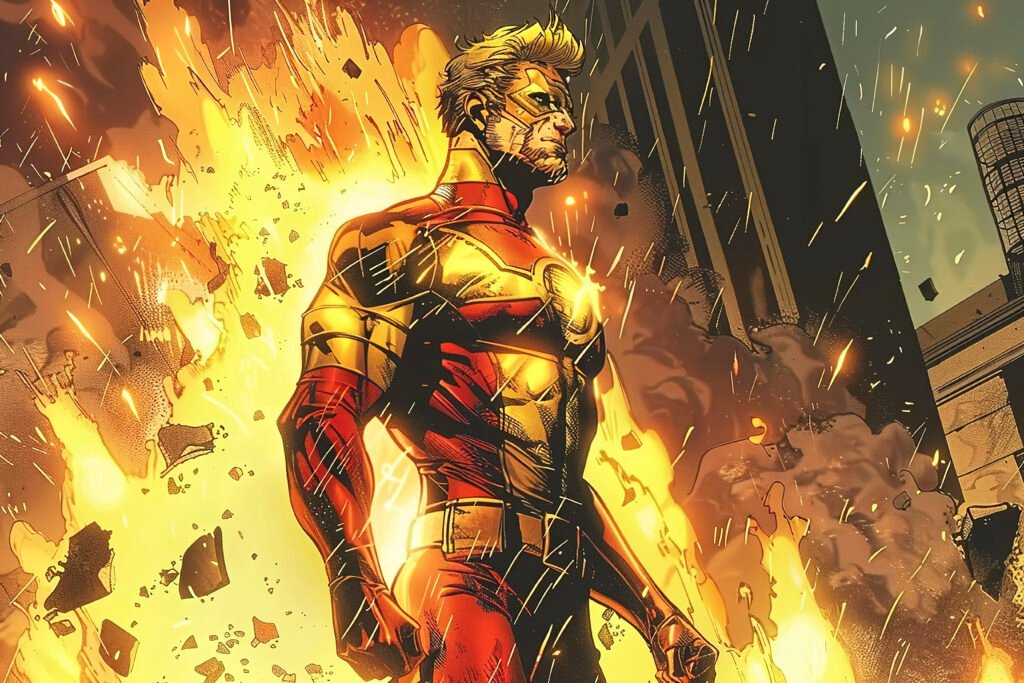This anniversary book chronicles 85 years in the history of one of the most iconic superheroes in comic book lore. Since his first appearance in Detective Comics #27 back in 1939, Batman has filled the imagination of fans worldwide, transforming from that dark vigilante into a beacon of justice and resilience. As the editors point out in their foreword, “His journey through the decades from comic books, through movies and television, to video games reveals a character across generations that appeals to young and old alike.”
This collection serves not only as a tribute to Batman but also as one to the world he exists within and to the creators who have helped mold his story. Readers will find much insight and retrospectives that address Batman’s influence on pop culture, tracing the transformation of the character throughout the years. Pointing out his iconic gadgets to some extremely memorable villains, the story of Batman reflects changes in society while maintaining a core of ethical dilemmas he faces. This 85th-anniversary edition gives old and new fans alike the opportunity to go back to Gotham City and the folklore that is the Dark Knight. Delve into the pages of this book and discover the timeless reasons behind Batman’s appeal and timeless themes that have made him more than just a cape-wearing hero.
The Birth of Batman: Origins of the Dark Knight
Batman’s origin can be traced back to the late 1930s when comic book creators Bob Kane and Bill Finger introduced a unique hero in Detective Comics #27. Inspired by pulp fiction, film noir, and characters like Zorro and Sherlock Holmes, they created a hero different from the bright-costumed superheroes of that era. Unlike Superman, who had incredible powers, Batman relied on his wit, resources, and pure determination. This choice set a much darker, grittier tone, defining him as a mortal with an unbreakable sense of justice and a mission to protect Gotham City.
The origin of Batman as the Dark Knight begins with personal tragedy: young Bruce Wayne witnesses his parents murdered in a Gotham alley, a sight that becomes his lifelong motivation. This plants in him the seeds of his dual identity a billionaire by day and a vigilante by night driven not by revenge, but by a commitment to rid his city of crime. Kane and Finger introduce readers to a character who, while unbreakable in spirit, was deeply human and vulnerable a man haunted by his past yet determined to shape his future.
Batman’s origin provided many core elements that remain true today: the vow he made as a young boy, his relentless pursuit of justice, and his reliance on intellect and physical strength rather than superhuman abilities. This foundation, set from Batman’s very first days, has endured through the decades, giving him a legacy that feels both mythic and relatable to readers. As the 85th-anniversary book shows, these roots are the starting point for a journey that would define not only Batman but also the modern superhero genre itself.
Batman Through the Decades: Evolution and Adaptation
As time went by, Batman adapted to reflect society’s changing values and tastes. In the 1940s, Batman’s early stories showed him as a tough detective up against dark, noir-inspired villains. This set him up as a determined crime-fighter in a gritty, dangerous Gotham City. But in the 1950s, comics became lighter, and Batman’s adventures turned more family-friendly with bright costumes, eccentric villains, and even sci-fi. This was a playful era, with Robin as a regular character, adding humor to Batman’s world.
In the 1960s, the campy style peaked with the live-action Batman TV show starring Adam West. Bright and filled with humor, the show turned Batman into a pop culture hit, loved by kids and adults, with memorable villains and a catchy theme song. By the 1970s, however, fans wanted Batman to return to his darker roots. Visionary creators like Dennis O’Neil and Neal Adams brought back the gritty, mysterious Batman from the early comics, grounding him again in Gotham’s grim world. This era helped Batman reclaim his identity as the Dark Knight a complex hero in a morally complex world.
The 1980s and 1990s were probably the most transformative years for Batman. Frank Miller’s The Dark Knight Returns reimagined Batman as a tougher vigilante in a dark, dystopian Gotham, while Batman: Year One gave a gritty look at his early days. These stories shaped the modern idea of Batman as a psychologically complex hero, moving comics, movies, and animation towards darker, more introspective storytelling. This time also saw Batman’s big-screen rise with Tim Burton’s movies, adding a gothic style that influenced Batman’s look for years.
As the 21st century began, Batman continued to evolve. Christopher Nolan’s Dark Knight trilogy brought a realistic, morally complex Batman, setting a new standard for superhero films. Comics like Hush and The Court of Owls added even more depth to his story and world. Over the decades, Batman has changed from a noir detective to a campy TV star, a gothic antihero, and a psychologically deep figure all while staying true to his core: Gotham’s watchful protector, adapting to new times but always dedicated to his mission.
Gotham’s Underworld: Iconic Villains and Allies

A hero is often defined by the enemies he faces, and Batman’s lineup of villains is just as famous as he is. Gotham City’s underworld is full of memorable villains who test Batman on every level physically, mentally, and morally. Leading the pack is the Joker, his chaotic arch-nemesis who represents pure anarchy. The Joker disrupts Batman’s sense of order and justice, acting as a twisted mirror to Batman’s own mind. Other top villains, like the Riddler, who is obsessed with showing he’s smarter, and Two-Face, who represents human duality, add different challenges to Batman’s battles.
These villains aren’t just criminals; each one has unique motives and layers that push Batman to question his own morals. Poison Ivy’s extreme environmental beliefs, Mr. Freeze’s desperate attempts to save his wife, and Bane’s mix of strength and brains all add new shades to what it means to be a villain. Many of these foes want more than just power or money they often represent distorted versions of Batman’s own struggles and traumas. Batman’s conflicts with his villains go beyond physical fights, delving into themes of identity, trauma, and redemption.
Batman’s world isn’t just filled with enemies; he also has a close group of allies who understand his mission and support him from behind the scenes. Alfred Pennyworth, his trusted butler and father figure, gives him emotional support and wise advice. Commissioner James Gordon, one of Gotham’s rare honest cops, shares Batman’s commitment to justice, working tirelessly to bring order to the city. Then there’s Robin, the young sidekick who started as a bright-eyed boy but grew into a complex character, often pushing Batman to face his own emotional challenges.
These relationships add humanity to Batman’s story, reminding readers that even a hero as solitary as Batman is stronger with people he can trust. Together, Batman’s allies and enemies create a richly layered Gotham, where every encounter shapes him and strengthens his role as the city’s protector.
Gadgets, Vehicles, and Tech: Tools of the Dark Knight
Batman’s use of technology and gadgets is legendary, much like his detective skills. Without superpowers, he relies on advanced tools that boost his abilities and keep him a step ahead of Gotham’s criminals. His most iconic tool, the utility belt, holds gadgets for any situation smoke bombs for fast escapes, grappling guns for quick movement, and Batarangs, his signature throwing weapons designed for accuracy and intimidation. Each gadget shows Batman’s cleverness and his ability to use resources in his fight against crime.
The Batmobile is a powerful symbol of his strength and presence. This heavily armored, high-tech vehicle includes everything from fast engines to defense systems and tracking devices, making it more than just a car—it’s a fortress on wheels. Over the years, the Batmobile has changed from a sleek, noir-inspired car to a tank-like machine capable of facing Gotham’s toughest threats. Each version shows Batman’s adaptability and the growing challenges he faces, keeping him at the cutting edge in his battle against Gotham’s underworld.
Beyond the basics, Batman’s tools highlight his sharp mind and planning skills, showing that he often thinks one step ahead of his enemies. His gadgets, from sonar tech for tracking crime lords to EMP devices that disable electronics, reflect his deep understanding of his opponents and his need to stay in control, even in unpredictable situations. His Batcave, a high-tech base, is equipped with advanced surveillance, research labs, and backup tools, reinforcing his role as a meticulous planner who is ready for anything.
Every gadget Batman uses is a key part of who he is, bridging the gap between human and hero. These tools give him more than an advantage they reflect his commitment to justice, his intelligence, and his unstoppable drive to protect Gotham at any cost.
In conclusion
Batman’s 85-year legacy shows the lasting power of a hero who is both strong and vulnerable. His tragic beginnings, complex relationships, clever gadgets, and endless ability to adapt have made him a powerful symbol of resilience and justice. Batman’s journey through changing times proves that he can evolve without losing his core values. His legacy goes beyond thrilling battles and iconic gear it’s the story of a man who, with only his intelligence and determination, inspires generations to stand against darkness. As fans read this anniversary book, they’re not just seeing Gotham’s protector but also the timeless human spirit in Batman, a legacy that will likely last for ages.


